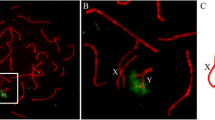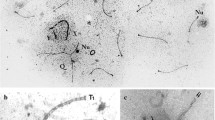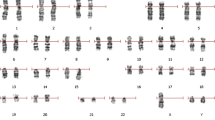Abstract
An infertile XYY man was studied by synaptonemal complex analysis of microspread spermatocytes and by quantitation of germ cells in semithin sections. All the 74 spermatocytes micrographed have an XYY constitution, and the biopsy shows a homogeneous arrest of spermatogenesis at the spermatocyte/young spermatid stages. The overwhelming majority (86%) of spermatocytes showed a Y—Y bivalent plus a univalent X. The Y—Y bivalent is totally synapsed in 48% of the cells. In the remaining cells, the YY bivalent has an average synaptic segment covering 43% of its length that always includes Yp. Another 9% of the spermatocytes showed an XYY trivalent and 4% of the spermatocytes showed univalence of the three gonosomes. Progression through all the pachytene substages was observed in cells with the two main synaptic configurations, but a high level of germ cell death was observed at or immediately after the meiotic divisions. The prevalence of Y—Y synapsis arises from the longer homologous region and the higher speed of pairing between the two Y chromosomes. Germ cell death is probably related to the univalence of the X chromosome. Synaptic competition between three gonosomes seems to be similar to that found in triploid birds but is somewhat different from that of XYY mice.
Similar content being viewed by others
References
Affara NA, Lau Y-FC, Briggs H, Davey P, Jones MH, Khwaja O, Mitchell M, Sargent C (1994) Report of the First International Workshop on Human Y Chromosome mapping. Cytogenet Cell Genet 67: 359–402.
Berthelsen JG, Skakkebaek NE, Perboll O, Nielsen J. (1981) Electron microscopical demonstration of the extra Y chromosome in spermatocytes from human XYY males. In: Byskov AG, Peters H, eds. Development and Function of Reproductive Organs. Amsterdam: Excerpta Medica, pp 328–337.
Blanco J, Rubio C, Simon C, Egozcue J, Vidal F (1997) Increased incidence of disomic sperm nuclei in a 47, XYY male assesed by fluorescent in situ hybridization (FISH) Hum Genet 99: 413–416.
Chandley AC, Fletcher J, Robinson A (1976) Normal meiosis in two 47, XYY men Hum Genet 33: 231–240.
Chevret E, Rousseau S, Monteil M, Usson Y, Cozzi J, Pelletier R, Sele B (1997) Meiotic behaviour of sex chromosomes investigated by three-colour FISH on 35142 sperm nuclei from two 47, XYY males. Hum Genet 99: 407–412.
Evans EP, Ford CE, Searle AG (1969) A 39X0/41XYY mosaic mouse. Cytogenetics 8: 87–96.
Evans EP, Ford CE, Chaganti RSK, Blanck CE, Hunter H (1970) XY spermatocytes in an XYY male. Lancet i: 719–720.
Evans EP, Beechey CV, Burtenshaw, MD (1978) Meiosis and fertility in XYY mice. Cytogenet Cell Genet 20: 249–263.
Gabriel-Robez O, Delobel B, Croquette MF, Rigot JM, Djelati R, Rumpler Y (1996) Synaptic behaviour of sex chromosomes in two XYY men. Ann Genet 39: 129–132.
Gillies CB (1989) Chromosome pairing and fertility in polyploids. In: Gillies CB, ed. Fertility and Chromosome Pairing: Recent Studies in Plants and Animals. Boca Raton: CRC Press, pp 137–176.
Grass F, McCombs J, Scott CL, Young RS, Moore CM (1984) Reproduction in XYY males: two new cases and implications for genetic counseling. Am J Med Genet 19: 553–560.
Howell WM, Black DA (1980) Controllled silver staining of nucleolus organizer regions with a protective colloidal developer: a 1 step method. Experientia 36: 1014–1015.
Hulten M (1970) Meiosis in XYY men. Lancet i: 717–718.
Hulten M, Pearson, PL (1971) Fluorescent evidence for spermatocytes with two Y chromosomes in an XYY male. Ann Hum Genet 34: 273–276.
Hunt PA, Eicher EM (1991) Fertile male mice with three sex chromosomes:Evidence that infertility in XYY male mice is an effect of two Y chromosomes. Chromosoma 100: 293–299.
Johannisson R, Gropp A, Winking H, Coerdt W, Rehder H, Schwinger E (1983) Down's syndrome in the male. Reproductive pathology and meiotic studies. Hum Genet 63: 132–138.
Melnyk J, Thompson H, Rucci A, Vanasek F, Hayes S (1969) Failure of transmission of the extra chromosome in subjects with 47, XYY karyotype. Lancet ii: 797–798.
Moore CA, Weaver DD (1990) Chromosome XYY. In: Buyse ML, ed. Birth Defects Encyclopedia. Cambridge: Blackwell, pp 400–401.
Nicklas BR (1997) How cells get the right chromosomes. Science 275: 632–637.
Rappold GA (1993) The pseudoautosomal regions of the human sex chromosomes. Hum Genet 92: 315–324.
Rasmussen SW, Holm PB (1979) Chromosome pairing in autotetra ploid Bombyx females. Mechanism for exclusive bivalent formation. Carlsberg Res Commun 44: 101–125.
Skakkebaek NE, Hulten M, Jacobsen P, Mikkelsen M (1973) Quanti-cation of human seminiferous epithelium. II. Histological studies in eight 47, XYY men. J Reprod Fert 32: 391–401.
Speed RM (1984) Meiotic con-gurations in female trisomy 21 foetuses. Hum Genet 66: 176–180.
Speed RM (1989) Heterologous pairing and fertility in humans. In: Fertility and Chromosome Pairing: Recent Studies in Plants and Animals. Boca Raton: CRC Press, pp 1–35.
Speed RM, Faed MJW, Batstone PJ, Baxby K, Barnetson W (1991) Persistence of two Y chromosomes through meiotic prophase and metaphase I in an XYY man. Hum Genet 87: 416–420.
Solari AJ (1980) Synaptonemal complexes and associated structures in microspread human spermatocytes. Chromosoma 81: 315–337.
Solari AJ (1988) Synaptic behaviour and recombination nodules in the human XY pair. Genetica 77: 149–158.
Solari AJ (1993) Sex Chromosomes and Sex Determination in Vertebrates. Boca Raton: CRC Press, pp 109–135.
Solari AJ, Pigozzi MI (1994) Fine structure of the XY body in the XY1Y2 trivalent of the bat Artibeus lituratus. Chrom Res 2: 53–58.
Solari AJ, Thorne MH, Sheldon BL, Gillies CB (1991) Synaptonemal complexes of triploid (ZZW) chickens: Z-Z pairing predominates over Z-W pairing. Genome 34: 718–726.
Stack SM, Herickhoff l, Sherman J, Anderson L (1991) Staining plant cells with silver. I. The salt-nylon technique. Biotech Histochem 1: 69–78.
Tease C (1990) Sex chromosome con-gurations in pachytene spermatocytes of an XYY mouse. Genet Res 56: 129–133.
Thompson H, Melnyk J, Hecht F (1967) Reproduction and meiosis in XYY men. Lancet ii: 831.
Walzer S, Gerald PS (1977) A chromosome survey of 13,751 male newborns. In: Hook EB, Porter IH, eds. Population Cytogenetics. New York: Academic Press, pp 45–61.
Author information
Authors and Affiliations
Corresponding author
Rights and permissions
About this article
Cite this article
Solari, A.J., Rey Valzacchi, G. The prevalence of a YY synaptonemal complex over XY synapsis in an XYY man with exclusive XYY spermatocytes. Chromosome Res 5, 467–474 (1997). https://doi.org/10.1023/A:1018469030537
Issue Date:
DOI: https://doi.org/10.1023/A:1018469030537




